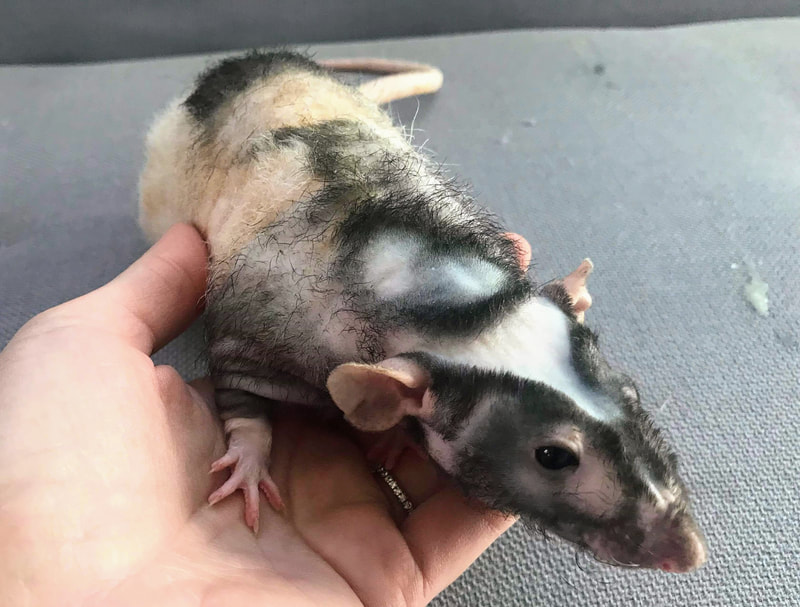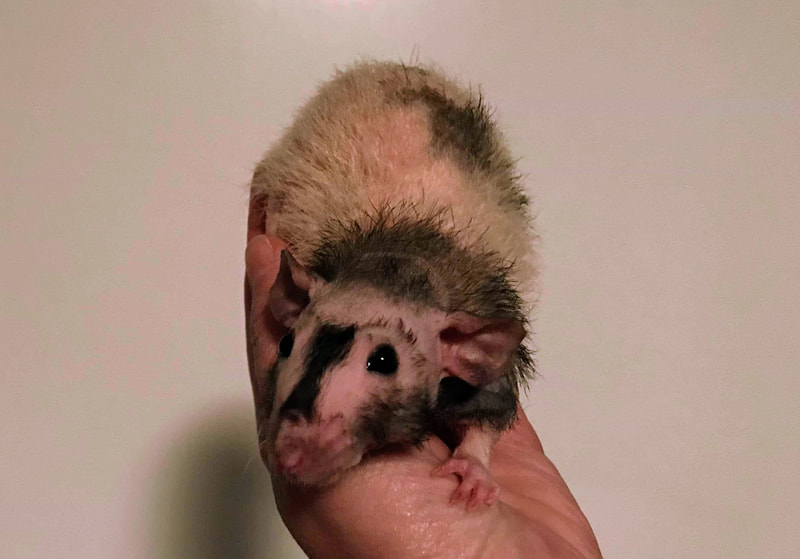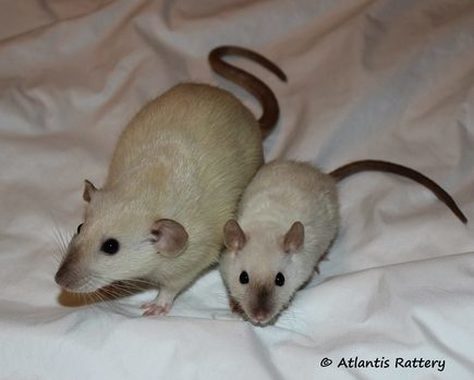|
5/11/2020 6 Comments What is a Werewolf Rat?The question I get most often. I will do my best to answer it. What is so confusing are the different names given to this gene and without getting too deep into genetics, the most simple description is this: Recessive gene (both parents must BE Werewolf or CARRY the Werewolf gene) that causes the rat to continuously molt in mostly symmetrical patterns over the body. It is most noticeable on the face where the coat is most dense. It is often referred to as 'True' Patchwork, This should not be confused with Double Rex which is a dominant gene. The gene was first described in the 1950's and was referred to as Naked. The gene was bred on and off by various breeders, but seemed to disappear, and was not seen for many years. It showed back up in feeder lines in 2017/18 and two different breeders purchased animals from the same feeder breeder. The two 'lines' were developed separately, one breeder referring to them as 'Patchwork' and the other as 'Werewolf'. I was lucky enough to have the opportunity to get animals from DemocRattery and received Demo Wellington and Demo Luperca to start my Werewolf program. The owner of DEMO discovered that at the follicular level, these rat's coats most similarly resembled that of the Lykoi or Werewolf Cat, hence she decided to use the name Werewolf. I also call mine Werewolf out of respect for DEMO, and the work she put into the line before I obtained it. I am also a huge fan of weird cats, I own 3 Sphynx (Hairless) cats, and have been enamored with the Lykoi Cat an example seen here, Atreyukatz Kalan, Black Roan Lykoi: The following are all pictures of DEMO Wellington 'Boots' in various stages of molt, as you can see they change drastically. Double Rex Patchwork, do not exhibit the same symmetrical patterns, although they do molt in 'patches'. Boots was a marked rat, with the shape of a Wellington Boot on his back. I have since bred away from markings, and the patterns do not show up well on the white part of the coat. Here are some pictures of baby werewolves at 10-12 days old, born to two different mothers. From this stage of roughly two weeks of age, the babies will grow a short wiry coat. By 4 weeks, they will be completely covered, then they start to 'Wolf Out' which is when they start their first moult. It begins with the babies losing the hairs around their eyes, the baldness progresses down each cheek, then the whole face. I love this stage in their development. Standing Stones Rattery is the proud owner of some EVO Werewolf, and has been documenting coat development and written a wonderful piece comparing Werewolf, Double Rex, and Hairless, including detailed pictures of the different coats and whiskers. Check out her work here. At this point they are going home to their new families, and the fun really begins. I love getting photos of everyone's babies and the changes they see almost weekly. These cuties are extremely social and loving, they enjoy being held, carried, and allowed to watch TV with you. They have brought me so much joy, I can't wait to share that joy with you.
#WerewolfRats, #EVORats #EvolutionRattery
6 Comments
Dwarf rats do not come from somewhere over the rainbow and are not like Munchkin Cats with the shortened limbs that are characteristic of their specific genetic mutation. Here is a great explanation of what a Dwarf rat is: Excerpt: ‘Dwarf Rats’ by Debbi J. Neeham, 2005 The spontaneous dwarf rat (SDR) was found in a laboratory colony of Sprague Dawley rats in 1977. It is a recessive mutation that causes them to have reduced GH or Growth Hormone which causes them to be up 40-75% smaller than their normal-sized counterparts, and in fact, a little larger than some fancy English mice. Dwarf rats have been found to be resistant to some cancers, as scientists have studied the effect of chemically induced cancer on dwarf rats and found dwarfs do not develop cancerous tumors like typically sized rats due to their lack of Growth Hormone. That is great news for those whom keep rats in the rat fancy! Do you love your standard size rats but sometimes wish they could have stayed the size when you first got them? Enter the Dwarf Rat! Standard size rat personality and charm wrapped up in baby rat size. Coming in at about 1/3rd the size of a standard rat (with 1/3rd the amount of cleanup!!) Dwarf rats have also been seen to live slightly longer than their standard counterparts I think due largely to the decreased size of a standard rat and instance of tumors/cancer. WIN WIN in my book. Dwarfs have some other characteristics that you should become familiar with to spot a true genetic dwarf as opposed to a runt, or rats that have been bred down in size over generations. Dwarfs have large eyes in proportion to their heads. This gives them that perpetual baby look like puppies and other baby animals. Their feet are smaller, but more proportionate to their size, and their tails are shorter and thinner without thickening at the base like a standard rat’s tail does. Here are some great pictures that capture those differences, courtesy of Atlantis Rattery. My Dwarf line was a bit of an experiment as I had no experience prior to my first breeding attempt, but it turned me into a complete dwarf lover and has been extremely successful. I LOVE my dwarfs; I wish they were more popular, I would miniaturize my entire rattery. I have enjoyed some wonderful surprises, like Merle Dwarf when trying for American Blue – go figure. Those are in breeding now, RROW Valentino and RROW Chanel. A big thank you to Atlantis Rattery and Rambling Rats Rattery for my foundation dwarfs/dwarf carriers that were bred to begin my lines. I have found my lines to have superior temperaments, readily accepting of any rat they are introduced to, and eagerly seeking attention from me and visitors to the rattery. They are usually the first to be hanging off the front of the cage wanting scritches and enjoy time outside the cage riding shoulders or dozing in pockets. One of my first Dwarf Bucks has become Georgie’s sidekick and cagemate, and showed me just how fearless these little guys are. Even as a wee baby, this rex fluffball would launch himself out of the top of a double critter nation cage as soon as I opened the door, not touching the sides and base-jump to the floor with his little legs spread-eagle. He earned his name ROAR Stuntman! He still does it, I just know to stand in front of the door and he lands on my chest and he skitters up to sit on my shoulder to groom himself. Speaking of fearless, my Dwarfs live quite happily with my standard rats, in groups of either boys or girls. I often find them cuddled up together using each other as pillows. Standards seem to not find the Dwarfs intimidating enough to bother with them, and the Dwarfs are fearless of the standards and are quite happy to roll a pushy standard and put him/her in their place. Dwarfs are active in their cages and despite their size do like and need a large cage. They love to run on wheels so make sure you find a quiet one. They can have a tendency to get overweight if they are kept in cramped cages or not given access to a wheel. I find mine enjoy ‘hand games’ and playing tag. Outside of the cage they are really quite cuddly and calm, and are often my travel buddies on trips to the drive-thru, sitting on the top of my headrest in the car. Note in the video below those are some of the biggest rats I have ever owned and one of the smallest dwarf bucks in my rattery. He is running on a 17" wheel - HIS wheel. In case you are interested, the wheel is one I made myself, this is the large 17", I also have a medium 12" that is perfect for females. They come in lots of different colors and are completely silent as I use inline skate bearings. I can make them to order.
If you have any questions about Dwarf rats, would like to come and visit Stuntman, or maybe pick up a dwarf or two of your own, feel free to contact me here. See you at the Rattery Soon!!! |
Melanie DeHavenOwner/Operator of EVO, all around animal lover and essential oil junkie. CategoriesAll Adopter Stories COVID Precautions Diet Essential Oils Husbandry Medical SBM/Rat Bite Fever Varieties |
Search by typing & pressing enter

















 RSS Feed
RSS Feed